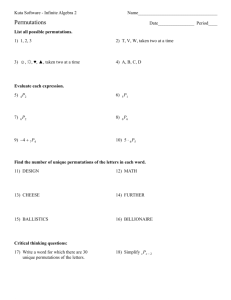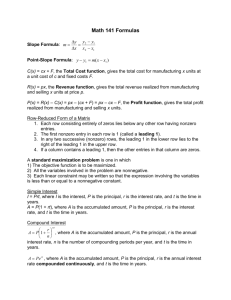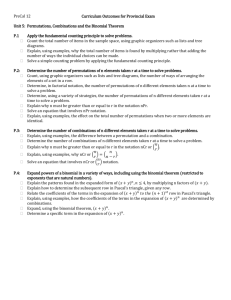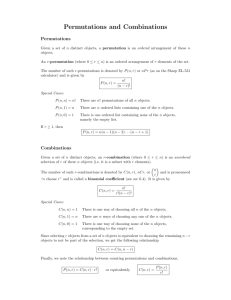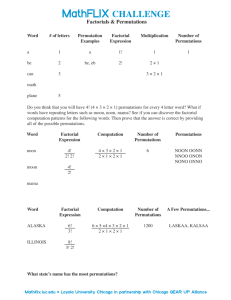Permutations—Counting
advertisement
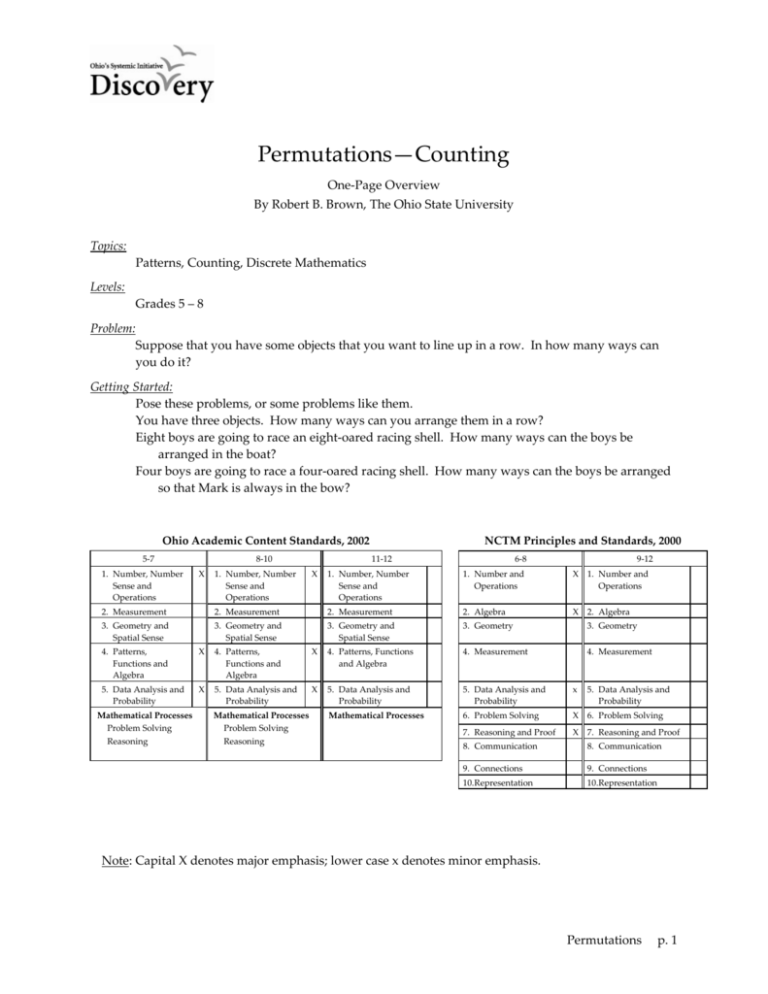
Permutations—Counting One‐Page Overview By Robert B. Brown, The Ohio State University Topics: Patterns, Counting, Discrete Mathematics Levels: Grades 5 – 8 Problem: Suppose that you have some objects that you want to line up in a row. In how many ways can you do it? Getting Started: Pose these problems, or some problems like them. You have three objects. How many ways can you arrange them in a row? Eight boys are going to race an eight‐oared racing shell. How many ways can the boys be arranged in the boat? Four boys are going to race a four‐oared racing shell. How many ways can the boys be arranged so that Mark is always in the bow? Ohio Academic Content Standards, 2002 8‐10 6‐8 1. Number and Operations 5‐7 11‐12 9‐12 1. Number, Number Sense and Operations X 1. Number, Number Sense and Operations X 1. Number, Number Sense and Operations 2. Measurement 2. Measurement 2. Measurement 2. Algebra X 2. Algebra 3. Geometry and Spatial Sense 3. Geometry and Spatial Sense 3. Geometry and Spatial Sense 3. Geometry 3. Geometry 4. Patterns, Functions and Algebra X 4. Patterns, Functions and Algebra X 4. Patterns, Functions and Algebra 4. Measurement 4. Measurement 5. Data Analysis and Probability X 5. Data Analysis and Probability X 5. Data Analysis and Probability 5. Data Analysis and Probability x 5. Data Analysis and Probability 6. Problem Solving X 6. Problem Solving 7. Reasoning and Proof X 7. Reasoning and Proof 8. Communication 8. Communication 9. Connections 9. Connections 10.Representation 10.Representation Mathematical Processes Problem Solving Reasoning Mathematical Processes Problem Solving Reasoning Mathematical Processes NCTM Principles and Standards, 2000 X 1. Number and Operations Note: Capital X denotes major emphasis; lower case x denotes minor emphasis. Permutations p. 1 Permutations—Counting By Robert B. Brown, The Ohio State University Topics: Patterns, Counting, Discrete mathematics Levels: Timing: Grades 5–8 Materials: One hour Prerequisites: Some distinguishable objects, such as colored chips or dice. Anything will do so long as each group can get a few distinguishable objects to work with. Multiplication of whole numbers Problem: Suppose that you have some objects that you want to line up in a row. In how many ways can you do it? Goals: • Introduce the notion of permutation Big Ideas: • Permutations • Patterns Permutations p. 2 Procedure: 1. Pose these, or similar, questions: You have three objects. How many ways can you arrange them in a row? Eight boys are going to race an eight‐oared racing shell. How many ways can the boys be arranged in the boat? Four girls are going to race a four‐oared racing shell. How many ways can the girls be arranged so that Sharon is always in the bow? 2. Break up the class into groups. Ask them to work on the problems and to write down others like them. 3. Reconvene the class. Let each group report on their solutions to the problems. (The number of ways of arranging three objects in a row is 3 × 2 × 1 = 6. The number of eight‐boy arrangements is 8 × 7 × 6 × 5 × 4 × 3 × 2 × 1 = 40230, and the number of four‐ girl arrangements with Sharon in the bow is the same as the total number of three‐ girl arrangements, which is 3 × 2 × 1 = 6.) Collect the newly written problems and reproduce them so that on another day everyone can have a copy of all of the problems. 4. Emphasize that in these problems the order or position of the objects is important. The arrangements are called permutations, and any difference in the order of the objects gives a different permutation. 5. The ultimate formula for getting the number of permutations is the following. If you have n objects, and you are going to place k of them in positions in a row, the number of ways of doing this is Pk = n × (n ‐ 1) × (n ‐ 2) × ... × (n ‐ k + 1). n If you are going to place all of the n objects, the number is Pn = n × (n ‐ 1) × (n ‐ 2) × ... × 1. n The last number, the product of all whole numbers from n down to 1, is called n factorial and is usually denoted by the symbol n! as shown below. n! = n × (n ‐ 1) × (n ‐ 2) × ... × 1. Permutations p. 3 The Mathematics: Let’s start with a simple problem. If you have a set of 5 objects and you want to know how many ways you can choose 2 of them and arrange the 2 in a row, here is how you can approach the problem. First choose an object for the first position in the row. There are 5 choices that you could make. Once you have made that choice, choose the object for the second position. Because you’ve already used an object for the first position there are only 4 left from which to choose for the second position. So, for each of the 5 choices for first position, there are 4 choices for second position, giving an overall number of choices of 5 × 4 = 20. P2 = 5 × 4 = 20. 5 If you have n objects and are choosing a row of 2, there are n × (n ‐ 1) ways of doing it. P2 = n × (n ‐ 1). n If you are placing all n objects in a row, the number of ways of doing this is: Pn = n × (n ‐ 1) × (n ‐ 2) × ... × 1 = n!. n If you are placing only k of the n objects in a row, you will be multiplying k factors together, and if you count carefully you will see that the smallest of the factors is n ‐ k + 1. (You don’t get down to n ‐ k because that would be the k + 1st factor.) Pk = n × (n ‐ 1) × (n ‐ 2) × ... x (n ‐ k + 1). n Extensions: A sophisticated way to extend this problem is to assume that some of the objects are indistinguishable. For example, suppose that you have 2 red chips and 3 blue chips that are indistinguishable except for color. How many ways are there of arranging 3 of them in a row? rrb, rbr, brr rbb, brb, bbr bbb Seven ways. Try to find general formulas for this situation. Permutations p. 4 Relationships to the Ohio Academic Content Standards, 2002: Grades 5‐7: Number, Number Sense and Operations Standard The student will be able to… • Use order of operations, including use of parenthesis and exponents to solve multi‐ step problems, and verify and interpret the results. Patterns, Functions and Algebra Standard The student will be able to… • Describe, extend and determine the rule for patterns and relationships occurring in numeric patterns, computation, geometry graphs and other applications. Data Analysis and Probability Standard The student will be able to… • Find all possible outcomes of simple experiments or problem situations, using methods such as lists, arrays and tree diagrams. Mathematical Processes Standard The student will be able to… • Apply and adapt problem‐solving strategies to solve a variety of problems, including unfamiliar and non‐routine problem situations. • Use inductive thinking to generalize a pattern of observations for particular cases, make conjectures, and provide supporting arguments for conjectures. Grades 8‐10: Number, Number Sense and Operations Standard The student will be able to… • Apply properties of operations and the real number system, and justify when they hold for a set of numbers. Patterns, Functions and Algebra Standard The student will be able to… • Generalize and explain patterns and sequences in order to find the next term and the nth term. Data Analysis and Probability Standard The student will be able to… • Use counting techniques, such as permutations and combinations, to determine the total number of options and possible outcomes. Permutations p. 5 Mathematical Processes Standard The student will be able to… • Formulate a problem or mathematical model in response to a specific need or situation, determine information required to solve the problem, choose a method for obtaining this information, and set limits for acceptable solution. • Apply reasoning processes and skills to construct logical verifications or counter‐ examples to test conjectures and to justify and defend algorithms and solutions. Relationships to the NCTM Principles and Standards, 2000: Grades 6‐8: Number and Operations Standard Instructional programs from pre‐kindergarten through grade 12 should enable all students to… • Understand meanings of operations and how they relate to one another. Algebra Standard Instructional programs from pre‐kindergarten through grade 12 should enable all students to… • Understand patterns, relations, and functions. • Represent and analyze mathematical situations and structures using algebraic symbols. Problem Solving Standard Instructional programs from pre‐kindergarten through grade 12 should enable all students to… • Build new mathematical knowledge through problem solving. • Solve problems that arise in mathematics and in other contexts. Reasoning and Proof Standard Instructional programs from pre‐kindergarten through grade 12 should enable all students to… • Make and investigate mathematical conjectures. Permutations p. 6
